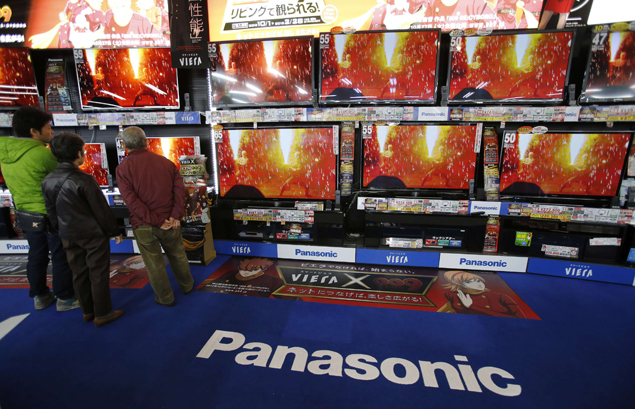Panasonic to shut down plasma TV production by March 2014: Report

In a golden era that began in the 1970s, the country's TV makers brought cutting-edge yet affordable technology and brand names like Sony, the Trinitron and Panasonic into living rooms across the West, at the expense of U.S. and European rivals.
But after dominating the business for decades, companies like Sony Corp, Sharp Corp and Panasonic have taken less than a decade to slide into deep losses, becoming also-rans to a new breed of nimble, cash-rich rivals like Samsung Electronics.
Osaka-based Panasonic will pull out of the plasma TV business by the end of the financial year to March 2014, sources familiar with the situation told Reuters on Wednesday. The news was first reported by the Nikkei business daily.
The end has come sooner than expected, underlining company president Kazuhiro Tsuga's determination to weed out weak operations as he focuses on higher-margin products to end years of losses at the consumer electronics conglomerate.
All that will remain of Japan's TV manufacturing are three cutting-edge liquid crystal display (LCD) plants, with Sharp's partially owned by foreign players, and a few assembly plants. Storied Japanese brands such as Toshiba Corp and Hitachi Ltd are outsourcing the bulk of their sets to other manufacturers.
Like the U.S. and European companies they defeated in the industry decades ago, the Japanese can chalk up their fate as much to hungry competitors as to their own mistakes.
"It wasn't just a failure of Japanese companies. It was also that rivals caught up quite fast," said Kun Soo Lee, analyst at industry research firm IHS iSuppli.
"The Japanese companies were probably a bit sentimental, underestimated their rivals and didn't form a competitive strategy."
The decline of Japan's TV business comes as the global industry faces a pivotal moment - how to cope with consumers around the world beginning to use their computers screen, laptops and tablets to watch more on-demand broadcasts and media content.
Global TV shipments dropped 6.3 percent in 2012, the first decline in over a decade according to research firm IHS iSuppli, with the flat-panel market reaching saturation after consumers in developed markets completed the switch from cathode ray tubes.
The shrivelling of the industry also comes as new leaders installed at Sony, Panasonic, Sharp and Toshiba over the past year-and-a-half make a significant break with the past - a difficult task in many Japanese corporations where the people who ran companies remain within the organisations' structures even after passing on the reins of leadership.
Japanese TV makers, while overlooking the ability of their rivals to build up a global brand quickly, did too little to protect their technology from rivals, were too easily convinced to spend big on projects and too slow to make strategic decisions to adjust to changing trends in demand.
Panasonic's plasma TV base at Amagasaki, a sprawling bayside complex midway between the western Japan cities of Osaka and Kobe, typified the last two problems. The newest of its factories had been in operation less than two years when Tsuga, then a senior managing director running the TV business, shut it along with another factory, leaving just one in operation.
Billion dollar losses
Panasonic's TV division has been a major contributor to the electronics company's combined $15 billion net loss in its two latest financial years. Its TV business posted an operating loss of 88.5 billion yen in the last financial year.
But Tsuga has waited until after Fumio Ohtsubo - the man who pushed Panasonic head-first into plasma with the 485 billion yen Amagasaki project - resigned as chairman in June to make the decision to pull the plug on plasma completely.
Sources familiar with the situation said on Wednesday that the No. 2 Amagasaki plant, the last in operation, would be shuttered within months and that the company would take a 40 billion yen impairment charge to cover the cost, likely out of the 120 billion yen earmarked for restructuring at the beginning of the year.
The 400 to 500 workers will be reassigned to other facilities in the company, the sources said.
"Even if they talk about reassignment, it won't be that easy," a worker in the plant in his 40s said as he left the facility on Wednesday, declining to give his name. "Things are tough at all of Panasonic's plants in Japan."
The closure will take Japan completely out of the plasma TV business, which has been eclipsed by sales of LCD televisions in recent years as they moved into larger-screen sizes, while South Korean rivals came to dominate plasma as well as LCDs.
Sony, which invented the Trinitron colour TV set that offered much brighter images, dominated the industry along with its Japanese peers from the 1970s until the end of the century, driving U.S. competitors such as General Electric, RCA, Sylvania and Magnavox out of the business.
But those decades of dominance ended abruptly as the Japanese giants stumbled in the shift to flat-screen TVs, taking billions of dollars in write-offs for failed efforts to keep pace with nimbler rivals elsewhere in Asia.
"Even with Panasonic withdrawing from plasma TVs, you can't say that Japan's TV industry is finished restructuring," said one analyst at a foreign securities house who asked not to be named. He said the companies still have bloated sales and administrative staff padding their fixed costs.
Panasonic still has a factory in western Japan making LCDs, but has said it will shift production from 80 percent for TVs to 80 percent for mobile gadgets. It has also launched pilot production of organic light-emitting diode screens, a possible future flat-screen technology, although Tsuga has said the company will be cautious about investment.
© Thomson Reuters 2013
Get your daily dose of tech news, reviews, and insights, in under 80 characters on Gadgets 360 Turbo. Connect with fellow tech lovers on our Forum. Follow us on X, Facebook, WhatsApp, Threads and Google News for instant updates. Catch all the action on our YouTube channel.
Related Stories
- Samsung Galaxy Unpacked 2025
- ChatGPT
- Redmi Note 14 Pro+
- iPhone 16
- Apple Vision Pro
- Oneplus 12
- OnePlus Nord CE 3 Lite 5G
- iPhone 13
- Xiaomi 14 Pro
- Oppo Find N3
- Tecno Spark Go (2023)
- Realme V30
- Best Phones Under 25000
- Samsung Galaxy S24 Series
- Cryptocurrency
- iQoo 12
- Samsung Galaxy S24 Ultra
- Giottus
- Samsung Galaxy Z Flip 5
- Apple 'Scary Fast'
- Housefull 5
- GoPro Hero 12 Black Review
- Invincible Season 2
- JioGlass
- HD Ready TV
- Laptop Under 50000
- Smartwatch Under 10000
- Latest Mobile Phones
- Compare Phones
- Huawei Nova 15
- Huawei Nova 15 Pro
- Huawei Nova 15 Ultra
- OnePlus 15R
- Realme Narzo 90x 5G
- Realme Narzo 90 5G
- Vivo S50 Pro Mini
- Vivo S50
- Asus ProArt P16
- MacBook Pro 14-inch (M5, 2025)
- OPPO Pad Air 5
- Huawei MatePad 11.5 (2026)
- Huawei Watch 10th Anniversary Edition
- OnePlus Watch Lite
- Acerpure Nitro Z Series 100-inch QLED TV
- Samsung 43 Inch LED Ultra HD (4K) Smart TV (UA43UE81AFULXL)
- Asus ROG Ally
- Nintendo Switch Lite
- Haier 1.6 Ton 5 Star Inverter Split AC (HSU19G-MZAID5BN-INV)
- Haier 1.6 Ton 5 Star Inverter Split AC (HSU19G-MZAIM5BN-INV)

















